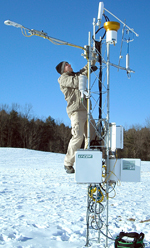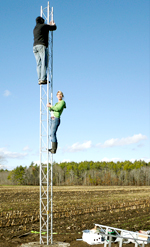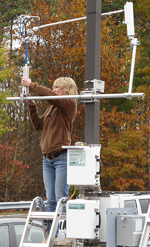Spring 2014
Earth Systems Science
SINCE 2003, the Bartlett Experimental Forest in the White Mountains has been New Hampshire's only site for a state-of-the-art instrument that takes the pulse of the landscape continuously.
 |
Now, as part of the National Science Foundation/NH Experimental Program to Stimulate Competitive Research (EPSCoR) program's Ecosystems and Society project, the capacity to gauge the land's vital signs has quadrupled and broadened with the installation of four "eddy flux" towers in forest, field, farmland, and an urban/residential environment.
That diverse spread of the towers will help the NH EPSCoR scientists understand land-use/land cover interactions with climate to better assess climate conditions in NH under future change scenarios—a central goal of the Ecosystems and Society project.
Three of the towers rise roughly 12-feet above ground, and are located at Kingman Farm in Madbury (field), Moore Fields in Durham (agricultural), and the West Edge Parking Lot on campus (urban/paved). The fourth is the 120-foot tower over a mixed forest located at Thompson Farm in Durham, which predates the recent EPSCoR effort and provides the platform for the flux instruments.
"A simple way to look at this is that the towers allow us to very accurately measure how these different landscapes 'breathe and sweat' and reflect light and heat throughout the day and night as environmental conditions change," says Earth Systems Research Center research scientist Andy Ouimette who, along with ESRC's Lucie Lepine, is heading up the flux tower work.
The "breathing" is the respiring of carbon dioxide (CO2), the reflection of light is what's known as albedo, and the sweating is evapotranspiration—a combination of simple water evaporation and that transpired to the atmosphere from plants.
Says Ouimette, "The effect of land cover on both local and larger scale climate processes is a result of all three of these processes, not just emissions of CO2."
For example, forested landscapes have traditionally been thought of as having a cooling effect on global climate due to their ability to take up and store CO2. However, compared to other land cover types, forests are dark and cause the Earth's surface to absorb a much higher proportion of incoming solar radiation (low albedo) than other land cover types. Despite their low albedo, forests tend to have a cooling effect on local climate because they sweat a lot (high evapotranspiration rates).
"A parking lot may be the other extreme," Ouimette says. "Urban surfaces tend to reflect a much higher proportion of incoming radiation but due to their inability to sweat or absorb CO2 have a warming effect on local and global climate."
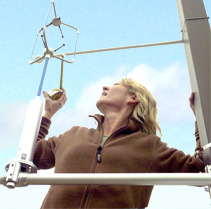 |
|
| Lucie Lepine calibrates the West Edge flux tower sensors. Photo by Andrew Ouimette, UNH-EOS. |
The towers, which are known formally as eddy covariance flux towers, are equipped with sensors that measure minute changes in the amounts of CO2 and water in turbulent air or "eddies" above the land surface. They also include a suite of meteorological sensors to measure incoming and reflected radiation, air and soil temperature and humidity, and precipitation, all of which provide information on energy fluxes between the biosphere and atmosphere.
"The towers can measure how fast the wind is moving in all directions—up, down, side-to-side, all around," says Ouimette, "and at the same time are measuring the amount of carbon and water vapor in that wind. And it does this twenty times per second."
When those measurements are compared and summed (the "covariance" part) over the course of a month or the year, the scientists know how much carbon has gone up or down. If more went up, the land is giving off carbon (a carbon source), and vice versa (a carbon sink).
Looking into the future
Having four flux towers strategically located in different environments will provide researchers with data that can be used in the Ecosystems and Society project's effort to create realistic future scenarios of what the Granite State could look like depending on land-use decisions.
With the eddy flux systems, the researchers are trying to get a handle on the microclimates of the different land cover/land-use types so that if, for example, there's a future scenario in which half the state gets developed or changes from agricultural to residential they'll know with some certainty how that might affect local-to-regional climate.
Says Lepine, "We're using a flux system over a parking lot, for example, as an end member for developed areas so we can get a sense of what kind of urban heat island effect there may be in future developed areas like Nashua or Manchester. By understanding how each component of the varying landscape contributes to the surface energy budget, we will be better able to estimate climate forcing under various land-use scenarios, which will help inform decisions about future land use."
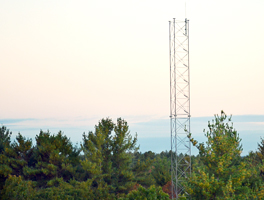 |
|
| 120 ft. flux tower at Thompson Farm Observatory.Photo by K.Donahue, UNH-EOS. |
The tower data will also help scientists understand the seasonal patterns of the differing landscapes. "And certainly for modeling future scenarios, it will be nice to capture a hot year versus a cold year, a wet year and a dry year, a winter with snow and one without and see how these four different systems respond," Ouimette says.
Lepine adds that the towers could also be a boon to other researchers within EOS and at UNH by adding additional research capacity to their current projects or project proposals. "For example, we're hoping the Water Systems Analysis Group would be interested in the evapotranspiration data we can capture by the eddy covariance method as a means for checking their estimates from hydrologic models."
"We're hoping these systems will lead to collaborations with a wide range of cutting-edge research projects across different scales," Ouimette notes. "For example, if someone is measuring the water use efficiency of individual trees or microbial activity in the soil they could correlate that smaller-scale focus to this whole ecosystem flux of carbon and water and climate data that we'll be gathering."
In this regard, the extended capabilities at the Thompson Farm Observatory, which is actively seeking collaborative research projects within and beyond UNH, will help broaden and expand the science. For more information, visit www.eos.unh.edu/observatories.
For more on the Ecosystems and Society project, visit http://www.epscor.unh.edu/ecosystemsandsociety.
